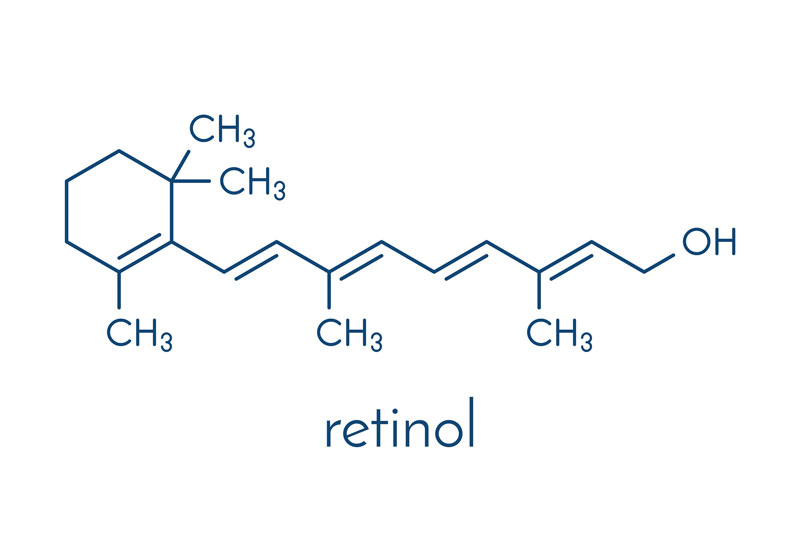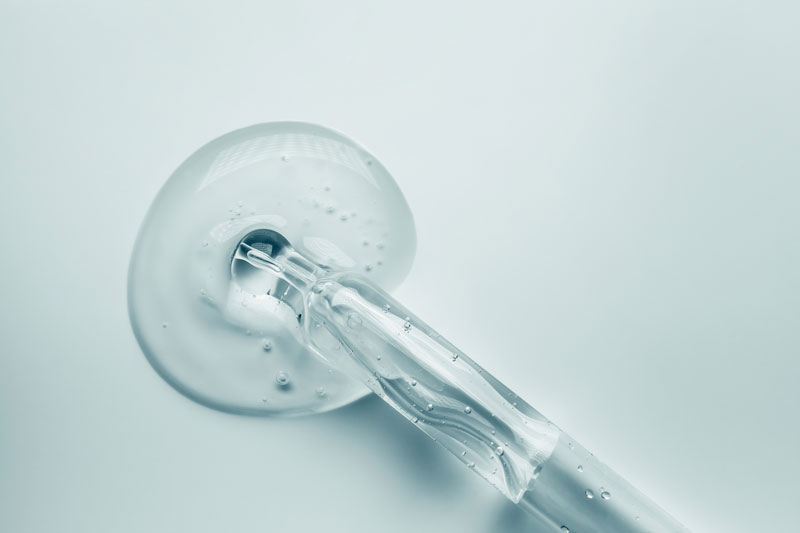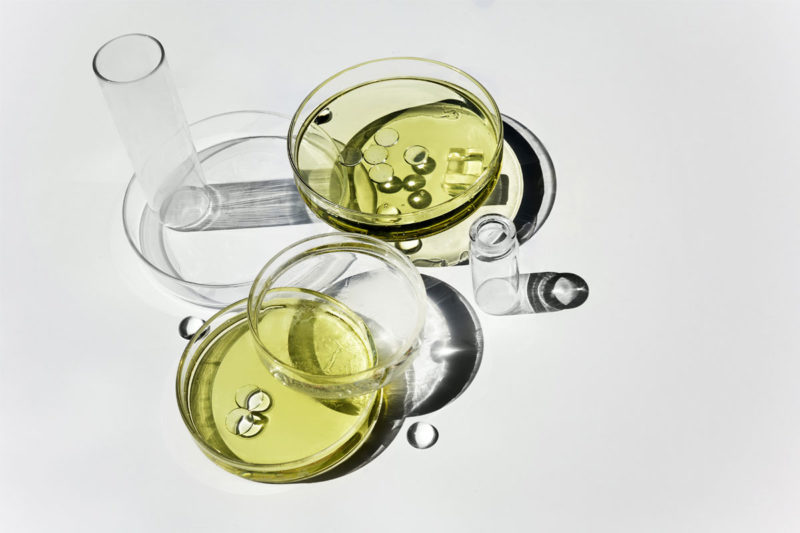INCI List
In the EU, since 1998, it has been mandatory for the INCI list, an abbreviation of International Nomenclature of Cosmetic Ingredients, to appear on either beauty products themselves or their cardboard outer packaging. It lists the ingredients in order of their proportions in the finished product, greatest first. Very often, the first ingredient on the list is water (aqua), because it forms the basis of all emulsions (creams), shower gels, shampoos, etc. Synthetic substances are stated in English, and natural ingredients (plant extracts and also water) in Latin. So if you have even a smattering of Latin, you can pick out the various ingredients, including decried ones or allergens, since it is mandatory for them to be stated at the bottom of the list.
Microbiote

We first encountered this term when we started to hear about the gut microbiome. The skin, too – and a number of other organs – are home to microbiomes made up of billions of living microorganisms called probiotics (bacteria, viruses and yeasts) which coexist and interact heavily with our cells. Richard L. Gallo, Chairman of the Department of Dermatology at the University of California in San Diego, discovered the skin microbiome. That discovery changed the way we look at skincare. He explains that “20 years ago, we thought that viruses and bacteria caused diseases. Now we know that the skin’s health depends on the balance between the probiotics in the skin microbiome”. The latter is made up of around a thousand different probiotics. The skin’s good health depends on their diverse nature and the balance between their populations. They play a protective role by forming a physical barrier and stimulating the skin’s immune system. Whenever pathogenic bacteria try to get a foothold, these probiotics produce substances to destroy them, sending messages to the cells of the epidermis instructing it to ramp up the immune response. But if the pathogenic bacteria manage to disrupt the microbiome, the skin shows signs of inflammation: redness, irritation or dryness, which can develop into conditions like acne and eczema.
Natural
A natural ingredient is one yielded from plant, animal, microorganism or mineral matter only (rather than being produced synthetically). However, these types of matter can be treated to extract active ingredients. That means that they are processed (either physically or chemically) and are then referred to as “of natural origin”. This processing is not necessarily a bad thing. For example, maceration, extraction, grinding and fermentation keep the virtues of natural ingredients intact. So a formulation can contain both natural ingredients and ingredients of natural origin, and state as much. They often account for up to 95% of the finished product or more.
ISO 16128 was introduced in 2017. It standardises these appellations and sets forth their terms of reference in an international agreement. This sets out definitions of natural and organic ingredients, natural and organic derivatives. It also dictates the way in which the proportions of natural and organic ingredients in finished products are to be calculated.
Niacinamide

This B vitamin is referred to variously as vitamin B3, vitamin PP or nicotinamide. Like other vitamins used in beauty products, it interacts with a great many of the skin’s mechanisms. At the surface, it bolsters the barrier function by stimulating the production of ceramides. These are lipids that form the cement between the cells of the stratum corneum, guarding against dehydration and infiltration by irritants. Niacinamide also regulates cell turnover and improves the skin’s texture, not least by tightening the pores and regulating sebum production. Moreover, it’s found in a great many products designed to treat acne. It supports the skin’s own antioxidant activity and lessens the damage done by blue light. Niacinamide is also well known for its powerful anti-hyperpigmentation proprieties by way of inhibition of melanin transfer, as well as its powerful anti-inflammatory proprieties. Lastly, it stimulates collagen production and guards it against destructive agents. Thus it has anti-ageing effects. Fun fact: here in France, chemists (who are purists) refer to ‘le’ niacinamide, since it is an amide (which takes the masculine article in French). However, most of those wanting to make science accessible to the wider public call it ‘la’ niacinamide, since it is a vitamin (which takes the feminine article).
Oxidation / Free radicals
Oxidative stress due to free radicals causes cell oxidation, a phenomenon similar to rusting. Under normal conditions, the body naturally produces “antidotes” to free radicals (superoxide dismutase, catalase and glutathione). However, the balance can be upset if excessive amounts of free radicals are formed due to significant exposure to UV rays, pollution, tiredness, stress or smoking. The free radicals then attack the cells’ proteins, DNA and membranes. The result is wrinkles and premature ageing. Hence the need to add antioxidants, such as vitamin C, vitamin E, polyphenols, etc. to skincare products.
PAO (Period After Opening)
This is simply a product’s shelf life once opened, as distinct from its expiry date. It is indicated on the product by way of an opened jar symbol with a digit and letter on the front, for example “12M” meaning 12 months.
Peptides
These are chains of amino acids which act as anti-ageing agents. Since amino acids are components of protein, they are naturally occurring in the skin and therefore are in perfect harmony with it. They can be dipeptides, tripeptides and so on and so forth… All the way up to hexapeptides or polypeptides, depending on the number of amino acids comprising them. They act as messengers which work mimetically and attach themselves to certain receptors in cells. So they coordinate a great many biological processes. They do not supply external active substances to the skin, but push it to regenerate itself. Some of them boost cell renewal, and others do the same to fibroblasts. This prompts the synthesis of collagen and elastin, and reduces deterioration. Others still have hydrating, soothing or even anti-glycation actions. Argireline, a hexapeptide, reduces the appearance of wrinkles caused by facial expressions by blocking the acetylcholine that causes them to form. As for proline, it boosts collagen synthesis… And the list goes on. Basically, the effects can be multiple since virtually every peptide has a specific action.
Proteins
Proteins are chains of amino acids which are much bigger and much more complex than peptides. They account for 27.5% of the skin. Its structural proteins are keratin, collagen and elastin – which are also found in claws, bones, tendons and ligaments. Proteins are also the main component of cells, accounting for more than 50% of their dry weight.
Retinol


Retinol (a derivative of vitamin A) is considered the star anti-ageing agent by dermatologists. They have been prescribing it for more than 40 years in its medical-grade form: retinoic acid (vitamin A acid). Like vitamins C, B3, and B5 which are also used in beauty products, retinol is versatile and works on a great many factors. It is known essentially for its anti-wrinkle properties, but also addresses age spots and the quality of the skin. This is because it works on all of the skin’s layers. At the surface, it has an exfoliating action which smooths out the skin, promotes radiance and unblocks the pores. It stimulates cell renewal, and in response prompts a slight thickening of the epidermis. Retinol also works on the key cells of the skin’s immune defences, and regulates the production of sebum and melanin. In the dermis it boosts collagen and elastin production, increases the proportion of hyaluronic acid and lessens the breakdown of the existing collagen. Lastly, retinol plays a significant role as an antioxidant. This explains why it tackles damage caused by sun exposure more effectively than ageing caused solely by the passage of time. So it’s worth embracing retinol, whether to address adult acne, a few wrinkles or age spots, greasy skin, thickened, uneven or sagging skin, or just a need for a radiance boost. The downside is that retinol is very instable in its pure form. It makes formulation tricky, and can be irritant at the effective concentration. It can be formulated in its pure form, combined with soothing or hydrating agents, or in a derivative form that’s easier to control (retinyl palmitate, acetate, linoleate or retinaldehyde). Retinol is best used overnight, to boost skin repair and because it does not react well to sunlight. It’s best avoided by those with hypersensitive or reactive skin.
Skin


The skin is the largest organ in the human body – totalling some 2m2. It comprises three layers – the epidermis, the dermis and the hypodermis. The most superficial layer of the epidermis – in contact with the outside – is the stratum corneum.
- The stratum corneum is made up of dead cells called corneocytes, which are keratinocytes (epidermis cells) which have lost their nuclei. They form a kind of brick wall, mortared with intercellular cement (ceramides). The surface of the stratum corneum is protected by the hydrolipidic film which, along with the skin microbiome, forms the skin’s protective barrier. If the cement is not of good quality, or if there are holes in the hydrolipidic film, the water evaporates and the skin gets dehydrated.
- As for the epidermis, it is made up of the following: keratinocytes which migrate little by little from the base of the epidermis to the stratum corneum and go through changes as they do so; melanocytes (which produce melanin); and Langerhans (immune) cells.
- The dermis is connective tissue that supports the epidermis, with which it is in constant communication through the dermoepidermic junction. The superficial dermis has an abundance of nerve endings, and is constantly in symbiosis with the epidermis. The deep dermis is dense connective tissue made up of the following, which are intertwined: cells known as fibroblasts, which make the fibres surrounding it (collagen and elastin) which impart density and elasticity to the skin; and the extracellular matrix, a kind of gel that gives the skin bounce and essentially consists of hyaluronic acid.
- The hypodermis lies beneath the dermis. It is crossed through by the vessels and nerves leading to the dermis, and houses adipocytes in which fats are stored.
Also in the dermis and hypodermis are the roots of the following: the sweat glands, which produce perspiration; the sebaceous glands, which secrete sebum; and hair follicles coupled with sebaceous glands.
Sulphates

Sulphates (sodium laureth sulphate, sodium lauryl sulphate and ammonium lauryl sulphate) are the main detergents found in most shampoos, shower gels and all laundry detergents. They cleanse – very effectively – and create those masses of lightweight lather that consumers are used to. The drawback: to cleanse, i.e. remove grease, styling product build-up, pollution, etc., you’re bound to have to strip the skin or hair a little. So they get criticised for being irritant and drying to the skin of the face and scalp, for “stripping” the hair and fading out hair dye. So in most formulations, sulphates are combined with other gentler detergents and hydrating agents, which have a soothing effect and compensate for their more aggressive action (aloe vera, glycerine, etc.). However, the fact remains that they are sometimes not well tolerated by those with coloured hair, curly hair or very sensitive skin on the face or scalp.
Laureth sulphate also gets criticised due to its production method. It involves ethylation, which is polluting and hazardous to anyone handling it. This explains why it is prohibited by the organic charter. Moreover, in December 2021, the Cosmébio organisation highlighted the problem posed by sulphur-based chemicals, of which sulphates are comprised. They cause acid rain and release aerosols into the atmosphere. So Cosmébio is urging its members to drop the use of sulphate-based emulsifiers from October 2022, and that of sulphate-based surfactants by October 2024.
Vitamin C
Vitamin C – or L-ascorbic acid – is essential for metabolism to take place. Known for ability to remedy tiredness, it also has an array of benefits for the skin. First and foremost it’s one of the most potent antioxidants, both directly and indirectly, since it reactivates the effects of vitamin E, another powerful antioxidant. It also plays a role in vascular protection. Vitamin C boosts both the cells of the epidermis (keratinocytes) and those of the dermis (fibroblasts). In the dermis, it stimulates the production of collagens I and III, and stops metalloproteinases from breaking down collagen. Thus it modifies the skin’s surface profile by reducing the appearance of wrinkles and oxidated melanin at the surface. Lastly, it inhibits tyrosinase, thus halting the production of melanin which causes age spots. So it has effects both on the skin’s radiance and its surface profile (from one week’s use), wrinkles (after two months’ use) and age spots (after three months’ use). Vitamin C is very hard to stabilise. You’ll find it pure in the form of vitamin C powder, which is to be mixed with a solution and used right away as a short-term course of treatment, or in a form that’s stabilised – not least using sugars.







